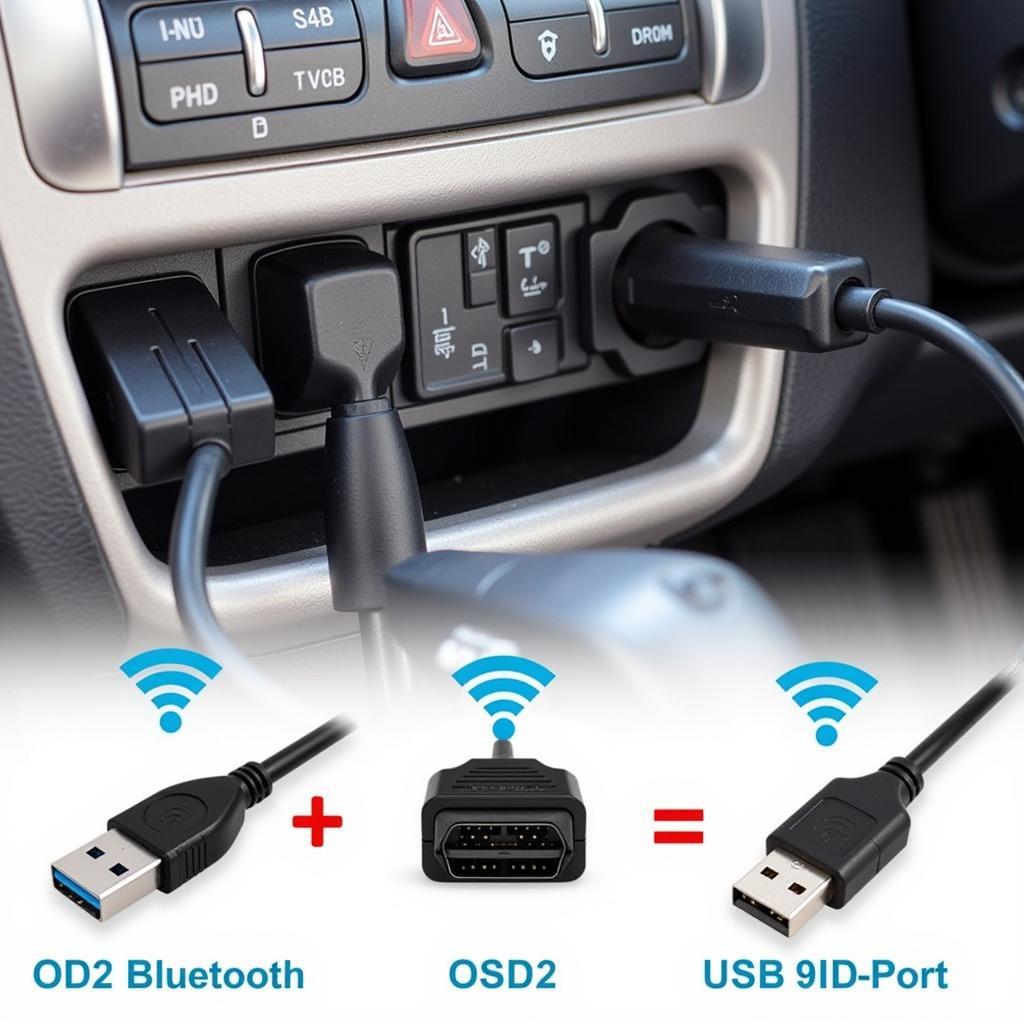The world of car repair can seem intimidating, but with the right tools and knowledge, anyone can diagnose and fix car problems. An OBD2 laptop car diagnostic setup provides a powerful and affordable way to understand your car’s health, saving you time and money on expensive mechanic visits. This guide will explore everything you need to know about OBD2 laptop car diagnostics, empowering you to take control of your car maintenance.
Understanding the Power of OBD2 Laptop Car Diagnostic Tools
OBD2, or On-Board Diagnostics, is a standardized system that allows you to access your car’s computer and retrieve valuable data about its performance. While simple OBD2 scanners can provide basic information, connecting your laptop unlocks a whole new level of diagnostic depth.
Why Choose an OBD2 Laptop Setup?
- Comprehensive Diagnostics: Access and analyze a wide range of data points beyond basic engine codes, including transmission, ABS, airbags, and more.
- Advanced Features: Utilize live data streaming, graphing, and logging capabilities to monitor real-time sensor readings and pinpoint intermittent issues.
- Cost-Effective Solution: Save money on repeated mechanic visits by identifying and even fixing some problems yourself.
- DIY Empowerment: Gain a deeper understanding of your car’s inner workings and feel confident tackling minor repairs.
 OBD2 Laptop Setup
OBD2 Laptop Setup
Choosing the Right OBD2 Laptop Car Diagnostic Setup for Your Needs
Selecting the right combination of software and hardware is crucial for an effective OBD2 laptop car diagnostic setup:
1. OBD2 Software: Your Window into Your Car’s Brain
OBD2 software acts as the interface between your laptop and your car’s computer. There are countless options available, ranging from free open-source programs to paid professional-grade software. Consider the following factors when choosing your software:
- Vehicle Compatibility: Ensure the software supports your car’s make, model, and year.
- Features and Functionality: Determine what level of diagnostic depth you need, such as live data, graphing, and advanced coding capabilities.
- User Interface: Opt for software with an intuitive and user-friendly interface, especially if you’re new to car diagnostics.
- Updates and Support: Look for software with regular updates to ensure compatibility with newer vehicle models and operating systems.
2. OBD2 Adapters: Bridging the Communication Gap
An OBD2 adapter is the physical device that connects your laptop to your car’s OBD2 port, usually located under the dashboard on the driver’s side. Various types of adapters exist, each with pros and cons:
- Bluetooth Adapters: Offer wireless convenience and are generally more affordable. However, signal strength can vary, potentially impacting data transmission.
- USB Adapters: Provide a reliable wired connection for stable data transfer, minimizing potential latency issues.
- Wi-Fi Adapters: Enable wireless connection with potentially greater range than Bluetooth, but may require additional setup procedures.
 Types of OBD2 Adapters
Types of OBD2 Adapters
3. Laptop Requirements: Ensuring Smooth Operation
While most modern laptops are capable of running OBD2 software, it’s essential to consider a few factors:
- Operating System Compatibility: Verify that the chosen software is compatible with your laptop’s operating system (Windows, macOS, Linux).
- Processing Power and Memory: For demanding software with live data and graphing features, a laptop with sufficient processing power and RAM is recommended.
- Storage Space: Depending on your chosen software and usage, allocate adequate storage space for software installation, data logs, and any saved reports.
Getting Started with OBD2 Laptop Car Diagnostics: A Step-by-Step Guide
Once you have your OBD2 laptop car diagnostic setup ready, you can begin diagnosing your car:
- Locate your car’s OBD2 port. It’s typically found under the dashboard on the driver’s side.
- Connect the OBD2 adapter to the port and your laptop.
- Install and launch the OBD2 software on your laptop.
- Turn on the ignition to provide power to the OBD2 port.
- Establish a connection between the software and your car’s computer.
- Read and interpret diagnostic trouble codes (DTCs).
- Clear codes after addressing the underlying issue.
[motor car diagnostic fault codes and their definitions](https://diagfixpro.com/motor-car-diagnostic-fault-codes-and-their definitions/) can help you understand what each code means.
Beyond Basic Diagnostics: Unlocking the Full Potential of OBD2 Laptop Car Diagnostics
Beyond reading and clearing codes, an OBD2 laptop setup opens up a world of possibilities:
- Live Data Monitoring: Observe real-time sensor readings to analyze engine performance, fuel economy, and more.
- Graphing and Data Logging: Visualize data trends over time, identify patterns, and diagnose intermittent problems.
- Component Activation: Test individual components like fuel injectors, solenoids, and relays to pinpoint malfunctions.
- Advanced Coding and Programming: Access and modify certain vehicle parameters, like enabling/disabling features or adjusting settings, with the appropriate software and knowledge.
Expert Insight: “An OBD2 laptop setup is an invaluable tool for anyone serious about DIY car repair,” says John Smith, a certified automotive technician with over 20 years of experience. “It empowers car owners with the knowledge to diagnose problems accurately, saving them time and money in the long run.”
Common OBD2 Laptop Car Diagnostic Issues and Troubleshooting Tips
While generally user-friendly, you might encounter occasional hiccups with your OBD2 laptop setup:
- Connection Problems: Ensure the adapter is securely connected to both the car and laptop. Check for damaged cables or loose connections. Try restarting your laptop and the car.
- Software Compatibility Issues: Verify that the software is compatible with your car’s make, model, and year. Update the software or try a different program if needed.
- Data Reading Errors: Interference from other electronic devices can disrupt data transmission. Turn off unnecessary devices and try repositioning the laptop or adapter.
Conclusion: Empower Yourself with OBD2 Laptop Car Diagnostics
An OBD2 laptop car diagnostic setup is an essential tool for any car owner looking to take control of their vehicle’s maintenance. By understanding your car’s inner workings and diagnosing problems early on, you can save time, money, and avoid unnecessary headaches. So, equip yourself with the right tools and knowledge, and embark on your journey towards confident and cost-effective DIY car repair.

Leave a Reply